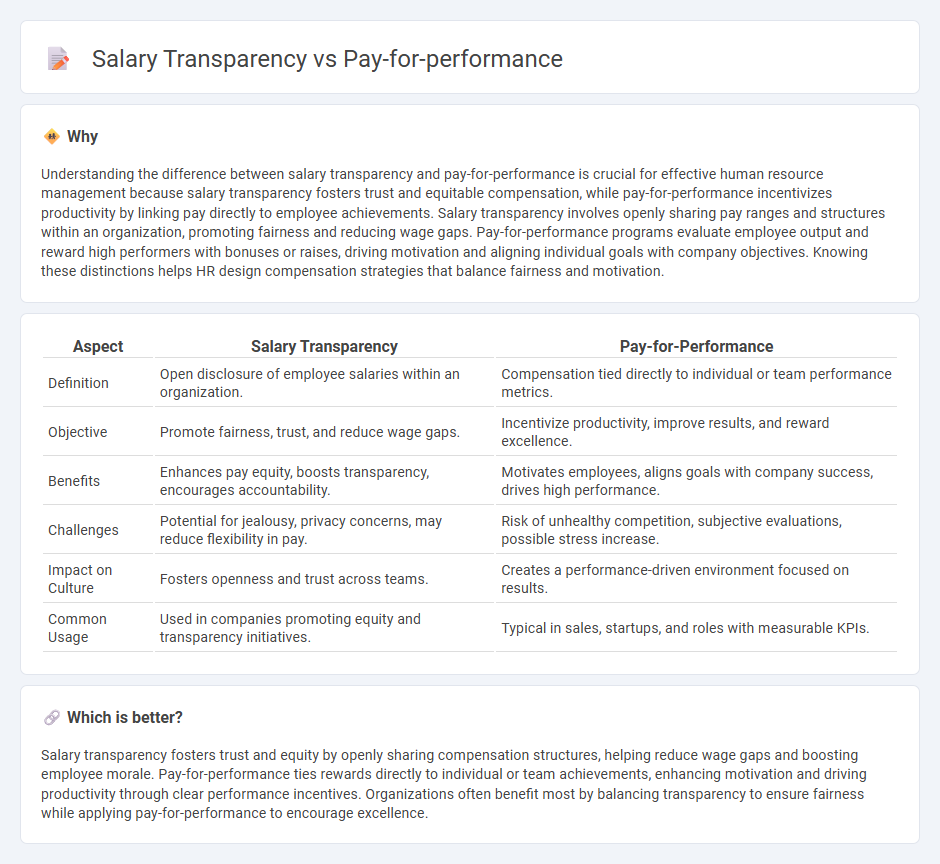
Salary transparency promotes open communication about employee compensation, fostering trust and reducing wage disparities within organizations. Pay-for-performance links employee earnings directly to individual or team achievements, driving motivation and aligning rewards with business goals. Explore how balancing these approaches can optimize workforce satisfaction and productivity.
Why it is important
Understanding the difference between salary transparency and pay-for-performance is crucial for effective human resource management because salary transparency fosters trust and equitable compensation, while pay-for-performance incentivizes productivity by linking pay directly to employee achievements. Salary transparency involves openly sharing pay ranges and structures within an organization, promoting fairness and reducing wage gaps. Pay-for-performance programs evaluate employee output and reward high performers with bonuses or raises, driving motivation and aligning individual goals with company objectives. Knowing these distinctions helps HR design compensation strategies that balance fairness and motivation.
Comparison Table
| Aspect | Salary Transparency | Pay-for-Performance |
|---|---|---|
| Definition | Open disclosure of employee salaries within an organization. | Compensation tied directly to individual or team performance metrics. |
| Objective | Promote fairness, trust, and reduce wage gaps. | Incentivize productivity, improve results, and reward excellence. |
| Benefits | Enhances pay equity, boosts transparency, encourages accountability. | Motivates employees, aligns goals with company success, drives high performance. |
| Challenges | Potential for jealousy, privacy concerns, may reduce flexibility in pay. | Risk of unhealthy competition, subjective evaluations, possible stress increase. |
| Impact on Culture | Fosters openness and trust across teams. | Creates a performance-driven environment focused on results. |
| Common Usage | Used in companies promoting equity and transparency initiatives. | Typical in sales, startups, and roles with measurable KPIs. |
Which is better?
Salary transparency fosters trust and equity by openly sharing compensation structures, helping reduce wage gaps and boosting employee morale. Pay-for-performance ties rewards directly to individual or team achievements, enhancing motivation and driving productivity through clear performance incentives. Organizations often benefit most by balancing transparency to ensure fairness while applying pay-for-performance to encourage excellence.
Connection
Salary transparency fosters trust and motivates employees by clearly aligning compensation with individual performance metrics. Pay-for-performance models rely on transparent salary structures to ensure fairness and drive productivity, reinforcing employee engagement. Transparent pay practices reduce wage disparities and promote accountability, solidifying the connection between performance outcomes and remuneration.
Key Terms
Incentive Compensation
Incentive compensation models differ significantly between pay-for-performance and salary transparency frameworks, with pay-for-performance directly linking rewards to measurable employee achievements, boosting motivation and productivity. Salary transparency fosters trust and equity within organizations by openly sharing compensation details, which can influence incentive structures through enhanced accountability and fairness. Explore how combining these approaches can optimize incentive compensation strategies for your business.
Equity
Pay-for-performance models reward employees based on measurable outcomes, often enhancing motivation but risking inequities if metrics are not standardized. Salary transparency promotes fairness by openly sharing compensation data, which can reduce wage gaps and build trust within organizations. Explore deeper insights on achieving equity through balanced pay-for-performance and transparent salary practices.
Accountability
Pay-for-performance systems enhance accountability by directly linking compensation to measurable outcomes, motivating employees to achieve specific targets. Salary transparency fosters organizational accountability by reducing wage disparities and promoting fairness, thereby increasing trust and employee engagement. Explore the impact of these compensation strategies on workplace accountability to make informed decisions.
Source and External Links
Performance-related pay - Wikipedia - Pay-for-performance is a salary system where pay is directly linked to how well an individual or team performs, often involving adjustments in pay bands based on performance evaluations, with rewards manifesting as either salary positioning or pay rises.
What Is Pay for Performance? Learn With Examples and Tips - Upwork - Pay for performance is a compensation strategy that rewards employees by linking pay increases or bonuses to performance goals, motivating and recognizing employees' contributions to the company.
The Pros and Cons of a Pay for Performance Model (p4p) - Factorial - A pay-for-performance model encourages employees to meet goals through monetary incentives like merit pay or bonuses but may have mixed effects on workplace culture despite being widely adopted in U.S. companies.
 dowidth.com
dowidth.com